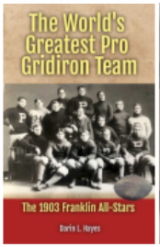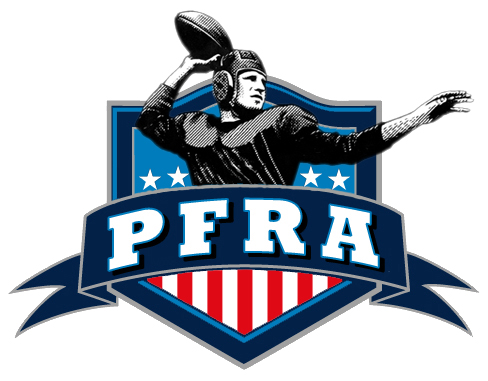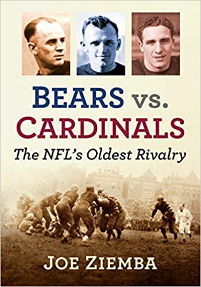Unearthing Football History's Pivotal Moments
Important events in sport for the 14th of April. See what famous, scandalous and notable sporting events happened on April 14. — www.onthisday.com
Dive into April 14th's captivating American football history! Discover tales of legendary players, surprising team origins, and the end of an era for a defensive titan. Unearth the stories behind iconic figures and pivotal moments that shaped the sport we love. Explore the rich tapestry of football's past!
April 14th marks a day filled with intriguing narratives in American football. From the unexpected naming of a storied franchise to the celebrated careers of gridiron heroes and the poignant farewell to a dominant force, this date holds a unique collection of memorable events that continue to resonate within the sport's vibrant history.
Sunsets on Jared Allen's Brilliant NFL Career
Star defensive end Jared Allen announced his retirement Thursday. NESN.com’s Michaela Vernava explains how the former Kansas City Chief, Chicago Bear, Minnes... — www.youtube.com
April 14th, defensive end Jared Allen signed a 1-day contract with the Vikings before retiring from football in 2016.
Allen a very productive defensive end played for the Chicago Bears, Minnesota Vikings, and Carolina Panthers.
A dominant force, Jared Allen earned 5 Pro Bowl selections and stands among an elite group of just 7 players to lead the NFL in sacks multiple times. His relentless pressure also resulted in 4 career safeties, tying for the most in league history. With 136.0 career sacks, Allen ranks as the 12th most prolific pass rusher in NFL history.
MY PODCASTS | ‣
How the Raiders are Named and The Best Back Grantland Rice Ever Saw & the Birth of an HOF Carlisle Player Not
COLLEGE HOF | ‣
Mal Stevens One of the Greatest Running Backs Ever
Gridiron greatness! Discover Mal Stevens, hailed by Grantland Rice as an all-time running back legend. From Washburn's quarterback to Yale's star halfback, his electrifying play paved the way to the College Football Hall of Fame. Explore the incredible journey of this football icon!
April 14, 1900, marked the birth of Mal Stevens in Stockton, Kansas. This figure's impact on American football spanned playing fields, sidelines, and even the medical profession. His journey through the sport is a testament to his multifaceted talents and enduring passion.
-College Career
Stevens' collegiate football career began at Washburn University, where he served as the starting quarterback from 1919 to 1921. His leadership and skills on the field quickly made him a notable player. In 1921, he transitioned to Yale University, initially playing halfback. It was during his time at Yale that his exceptional talent truly blossomed. Grantland Rice, the renowned sports journalist, famously hailed Stevens in 1923 as "one of the greatest running backs I ever saw," a powerful endorsement of his abilities. The 1923 Yale team, featuring Stevens alongside future Hall of Famers Bill Mallory and Century Milstead, achieved an undefeated 8-0 season, dominating their opponents with a remarkable 230-38 scoring differential.
-Road to the Pro Game
While Stevens achieved legendary status in college football, his direct professional playing career was brief. The provided information indicates he played for the Brooklyn Dodgers in 1946. However, his impact on the professional game extended far beyond his playing days. After his stellar collegiate career, Stevens embarked on a coaching path, beginning as an assistant coach at Yale from 1924 to 1927. He then ascended to the head coaching position at his alma mater from 1928 to 1932, becoming the youngest head coach at a major program at just 28 years old. Following a stint as freshman coach at Yale in 1933, he took on the head coaching role at New York University from 1938 to 1941. His experience at the collegiate level paved the way for his role as head coach of the Brooklyn Dodgers of the All-America Football Conference (AAFC) in 1946, showcasing his leadership at the professional level. Notably, Stevens simultaneously pursued and obtained his medical degree from Yale. During his coaching tenures at both Yale and NYU, he also taught orthopedic surgery, highlighting his exceptional intellect and dedication to both athletics and medicine.
-Football Legacy
Mal Stevens' football legacy is profound and multifaceted. His on-field prowess as a dominant running back at Yale earned him significant acclaim, culminating in his induction into the College Football Hall of Fame in 1974. Beyond his playing days, his successful coaching career at both the collegiate and professional levels left an indelible mark on the sport. His tenure as head coach at Yale, where he achieved considerable success and became the youngest head coach nationally at a major school, further solidified his reputation as a knowledgeable and effective leader. His election as president of the American Football Coaches Association in 1931, at the young age of 31, underscores the respect and admiration he commanded within the coaching community. Stevens' ability to excel in both the demanding worlds of high-level football and medicine is a testament to his exceptional discipline and intellect, making him a truly unique and influential figure in the history of the sport.
-Accolades, Awards and Career Stats
-College Football Hall of Fame Inductee (1974)
-Grantland Rice's tribute: Recognized as "one of the greatest running backs I ever saw" in 1923.
-Part of the undefeated (8-0) 1923 Yale team that significantly outscored opponents.
-Youngest Head Coach at a Major School (Yale, 1928) at age 28.
-Youngest President of the American Football Coaches Association (1931) at age 31.
Specific collegiate and professional playing statistics are not detailed in the provided information, but his Hall of Fame induction and Rice's tribute speak volumes about his impact as a player.
April 14, 1900, marked the birth of Mal Stevens in Stockton, Kansas. This figure's impact on American football spanned playing fields, sidelines, and even the medical profession. His journey through the sport is a testament to his multifaceted talents and enduring passion.
-College Career
Stevens' collegiate football career began at Washburn University, where he served as the starting quarterback from 1919 to 1921. His leadership and skills on the field quickly made him a notable player. In 1921, he transitioned to Yale University, initially playing halfback. It was during his time at Yale that his exceptional talent truly blossomed. Grantland Rice, the renowned sports journalist, famously hailed Stevens in 1923 as "one of the greatest running backs I ever saw," a powerful endorsement of his abilities. The 1923 Yale team, featuring Stevens alongside future Hall of Famers Bill Mallory and Century Milstead, achieved an undefeated 8-0 season, dominating their opponents with a remarkable 230-38 scoring differential.
-Road to the Pro Game
While Stevens achieved legendary status in college football, his direct professional playing career was brief. The provided information indicates he played for the Brooklyn Dodgers in 1946. However, his impact on the professional game extended far beyond his playing days. After his stellar collegiate career, Stevens embarked on a coaching path, beginning as an assistant coach at Yale from 1924 to 1927. He then ascended to the head coaching position at his alma mater from 1928 to 1932, becoming the youngest head coach at a major program at just 28 years old. Following a stint as freshman coach at Yale in 1933, he took on the head coaching role at New York University from 1938 to 1941. His experience at the collegiate level paved the way for his role as head coach of the Brooklyn Dodgers of the All-America Football Conference (AAFC) in 1946, showcasing his leadership at the professional level. Notably, Stevens simultaneously pursued and obtained his medical degree from Yale. During his coaching tenures at both Yale and NYU, he also taught orthopedic surgery, highlighting his exceptional intellect and dedication to both athletics and medicine.
-Football Legacy
Mal Stevens' football legacy is profound and multifaceted. His on-field prowess as a dominant running back at Yale earned him significant acclaim, culminating in his induction into the College Football Hall of Fame in 1974. Beyond his playing days, his successful coaching career at both the collegiate and professional levels left an indelible mark on the sport. His tenure as head coach at Yale, where he achieved considerable success and became the youngest head coach nationally at a major school, further solidified his reputation as a knowledgeable and effective leader. His election as president of the American Football Coaches Association in 1931, at the young age of 31, underscores the respect and admiration he commanded within the coaching community. Stevens' ability to excel in both the demanding worlds of high-level football and medicine is a testament to his exceptional discipline and intellect, making him a truly unique and influential figure in the history of the sport.
-Accolades, Awards and Career Stats
-College Football Hall of Fame Inductee (1974)
-Grantland Rice's tribute: Recognized as "one of the greatest running backs I ever saw" in 1923.
-Part of the undefeated (8-0) 1923 Yale team that significantly outscored opponents.
-Youngest Head Coach at a Major School (Yale, 1928) at age 28.
-Youngest President of the American Football Coaches Association (1931) at age 31.
Specific collegiate and professional playing statistics are not detailed in the provided information, but his Hall of Fame induction and Rice's tribute speak volumes about his impact as a player.
COLLEGE HOF | ‣
Eddie Rogers College Football Legend
The Gophers oldest Hall of Fame inductee may be one of the least well known, but has an incredible story. Ed Rogers may be the best Native American to ever suit up for the University of Minnesota. — www.thedailygopher.com
If you look back at successful football programs from a century ago you can always find those players that personified the school and the era. For the Golden Gophers it may be the legendary Ed Rogers that fits this mold.
Minnesota football Legend Ed Rogers. Born April 14, 1876, in Libby, Minnesota, was the standout end of Carlisle Indian Industrial School from 1896 to 1898 and with Minnesota from 1900 to 1903, Eddie Rogers.
Eddie was raised as a free spirit as his mother was a native American from the Chippewa tribe and his father was a lumber jack in the wilds of the pioneer frontier according to his bio on the NFF’s website. This rearing set his athleticism and ability to quickly react to almost any situation for his later life including his time on the gridiron. Rogers time with the Redman teams of Carlisle helped take the Institution’s football program to national prominence almost a full decade before Jim Thorpe attended the school and a year or two before Pop Warner started his coaching tenure there as well. As a member of the Golden Gophers in 1903 Eddie’s Minnesota team had a 11-0-1 record. In 1904 Rogers was head coach at Carlisle, and had a 9-2 record. The following year he returned to Minneapolis and began practicing law. He practiced law 62 years, 1905- 66, retiring at the age of 90. Eddie Rogers received the great honor of being selected for inclusion into the College Football Hall of Fame in 1968.
COLLEGE HOF | ‣
Harry Gilmer 'Bama Gridiron Legend
Harry Vincent Gilmer Jr. was born in Birmingham, Alabama on April 14, 1926. A talented athlete who excelled in multiple facets of the game, Gilmer left an enduring legacy in college and professional football.
-College Career
Gilmer's college football career flourished at the University of Alabama from 1944 to 1947. He primarily played left halfback and quickly became known for his dynamic style of play. A unique aspect of his game was his "jump pass," a technique he developed in his youth while playing with taller teammates. This innovative approach became a signature move at the collegiate level. His freshman year saw him achieve a perfect 8-for-8 passing performance in the Sugar Bowl against Duke. His sophomore season was particularly outstanding, as he led the nation in touchdown passes (13) and also rushed for nine touchdowns. He amassed 1,457 yards of total offense, placing him second nationally, with a passing percentage of .648 on 88 attempts and a 7.0-yard average on 79 rushing attempts. Gilmer's versatility extended to punting and kickoff/punt returns. In his junior year, he led the nation in punt return average (14.5 yards on 37 returns). During the 1945 season, he guided Alabama to victory in the Rose Bowl against the University of Southern California (34-14). Over his Alabama career, Gilmer compiled impressive statistics, showcasing his all-around talent.
-Road to the Pro Game
Gilmer's exceptional college performance made him the first overall pick in the 1948 NFL Draft, selected by the Washington Redskins. He played for the Redskins from 1948 to 1954, displaying his skills as both a halfback and quarterback. In 1955, he was traded to the Detroit Lions, where he played for two seasons (1955-1956) under head coach Buddy Parker.
-Football Legacy
Harry Gilmer's football legacy is defined by his versatility, athleticism, and innovative playing style. His "jump pass" became a hallmark of his game and influenced future generations of quarterbacks. His college career at Alabama established him as one of the most talented players of his era, earning him a place in the College Football Hall of Fame. His professional career in the NFL further solidified his reputation as a dynamic and effective player. Beyond his playing career, Gilmer continued to contribute to the sport as an assistant coach with the Pittsburgh Steelers (under Parker) and the Minnesota Vikings. He later served as the head coach of the Detroit Lions starting in January 1965, demonstrating his leadership and football acumen.
-Accolades, Awards, and Career Stats
-College Football Hall of Fame Inductee (1993)
-Twice finished fifth in Heisman Trophy voting (1945, 1947)
-Alabama Career Stats:
-Passed for 26 touchdowns
-Ran for 24 touchdowns
-Passed for 2,894 yards
-Rushed for 1,673 yards
-Punting average: 36.4 yards
-Kickoff return average: 28.7 yards
-Punt return average: 13.5 yards
Harry Gilmer's career spanned successful stints in college and the NFL, leaving behind a lasting impact on American football. He died on August 20, 2016.
-College Career
Gilmer's college football career flourished at the University of Alabama from 1944 to 1947. He primarily played left halfback and quickly became known for his dynamic style of play. A unique aspect of his game was his "jump pass," a technique he developed in his youth while playing with taller teammates. This innovative approach became a signature move at the collegiate level. His freshman year saw him achieve a perfect 8-for-8 passing performance in the Sugar Bowl against Duke. His sophomore season was particularly outstanding, as he led the nation in touchdown passes (13) and also rushed for nine touchdowns. He amassed 1,457 yards of total offense, placing him second nationally, with a passing percentage of .648 on 88 attempts and a 7.0-yard average on 79 rushing attempts. Gilmer's versatility extended to punting and kickoff/punt returns. In his junior year, he led the nation in punt return average (14.5 yards on 37 returns). During the 1945 season, he guided Alabama to victory in the Rose Bowl against the University of Southern California (34-14). Over his Alabama career, Gilmer compiled impressive statistics, showcasing his all-around talent.
-Road to the Pro Game
Gilmer's exceptional college performance made him the first overall pick in the 1948 NFL Draft, selected by the Washington Redskins. He played for the Redskins from 1948 to 1954, displaying his skills as both a halfback and quarterback. In 1955, he was traded to the Detroit Lions, where he played for two seasons (1955-1956) under head coach Buddy Parker.
-Football Legacy
Harry Gilmer's football legacy is defined by his versatility, athleticism, and innovative playing style. His "jump pass" became a hallmark of his game and influenced future generations of quarterbacks. His college career at Alabama established him as one of the most talented players of his era, earning him a place in the College Football Hall of Fame. His professional career in the NFL further solidified his reputation as a dynamic and effective player. Beyond his playing career, Gilmer continued to contribute to the sport as an assistant coach with the Pittsburgh Steelers (under Parker) and the Minnesota Vikings. He later served as the head coach of the Detroit Lions starting in January 1965, demonstrating his leadership and football acumen.
-Accolades, Awards, and Career Stats
-College Football Hall of Fame Inductee (1993)
-Twice finished fifth in Heisman Trophy voting (1945, 1947)
-Alabama Career Stats:
-Passed for 26 touchdowns
-Ran for 24 touchdowns
-Passed for 2,894 yards
-Rushed for 1,673 yards
-Punting average: 36.4 yards
-Kickoff return average: 28.7 yards
-Punt return average: 13.5 yards
Harry Gilmer's career spanned successful stints in college and the NFL, leaving behind a lasting impact on American football. He died on August 20, 2016.
Related Titles
APRIL 14TH GRIDIRON GIANTSRelated Categories
FOOTBALL HISTORY, COLLEGE HOF, MY PODCASTSRelated Searches
EventDay:April 14, Podcast:Football, Washburn, football position:quarterback, NCAAF Jersey:Number 19, football position:end, NCAAF Jersey:Number 52, football position:halfback, NFL Jersey:Number 52, NFL Jersey:Number 12, 1948 NFL Draft









